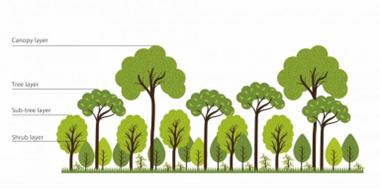The Challenge
Little Forests Kingston was looking for ways to recruit people to plant trees in neighbourhoods lacking tree equity. More specifically, they wanted to explore how they could engage landlords and/or homeowners in areas of the City suffering tree inequity.
About the Project
Little Forests Kingston are collaborations between plants, soil, organisms, climate, geology, land and people. Together with collaborators, Little Forests Kingston is working to bring 3-30-300 tree equity to Kingston: every child can see 3 trees from their window, live in a neighbourhood with at least 30% quality canopy & live within 300 metres of a quality greenspace. They believe Little Forests in every neighbourhood – linked by ecological corridors — are powerful catalysts for bringing climate, social and multispecies justice into the city.
Some relevant statistics include:
- Southern Ontario has hardly any forest left (80% of Indigenous forests are gone) and the fraction that remains is severely fragmented.
- Climate change has driven widespread declines in bumblebee and other native bee populations.
- Nearly 3 billion (29%) of birds gone since 1970.
- Over half of the 690 species of conservation concern in Ontario use habitat in southern Ontario forests.
- For healthy ecosystems, we need 50% forest cover.
A key collaborator with Little Forests is the Public Works department (City of Kingston) that runs the Neighbourhood Tree Planting Program. The Neighbourhood Tree Planting Program offers property owners within the City of Kingston an opportunity to purchase trees for a discounted rate to plant on their private property. Acting on the City’s strategic priorities to demonstrate leadership on climate action and to foster healthy citizens and vibrant spaces, the program encourages the community to help grow and preserve Kingston’s tree canopy. Other collaborators include Pathways to Education (Rideau Heights) and Kingston Secondary School (Kingscourt) who are both involved in prototyping a Neighbourhood Climate Resilience Assessment Toolkit which is closely tied to this challenge.
Public Works has identified neighbourhoods with a larger % than normal number of rental properties. In these areas, Landlords are often reluctant to plant trees as they perceive that they will increase crime. Similarly, private homeowners are often of the view that trees bring expense due to potential damage, as well as increased cost and time due to maintaining the trees themselves, as well as the surrounding area(s). With the view that trees are messy and/or require maintenance, they are often either not planted or cut down for these reasons alone.
Project Results
An interdisciplinary team of 4 students, reviewed the literature in four main research areas. At the end of the project they presented their findings and provided:
- a report (with recommendations)
- two (2) identified strategic partnerships (with initial discussions having taken place)
- educational materials for LFK to use when promoting their organization to the local community (slide deck and four (4) FAQ handouts)
Want to learn more about this project or organization? Contact the Experiential Learning & Programming Team asc.el@queensu.ca.
